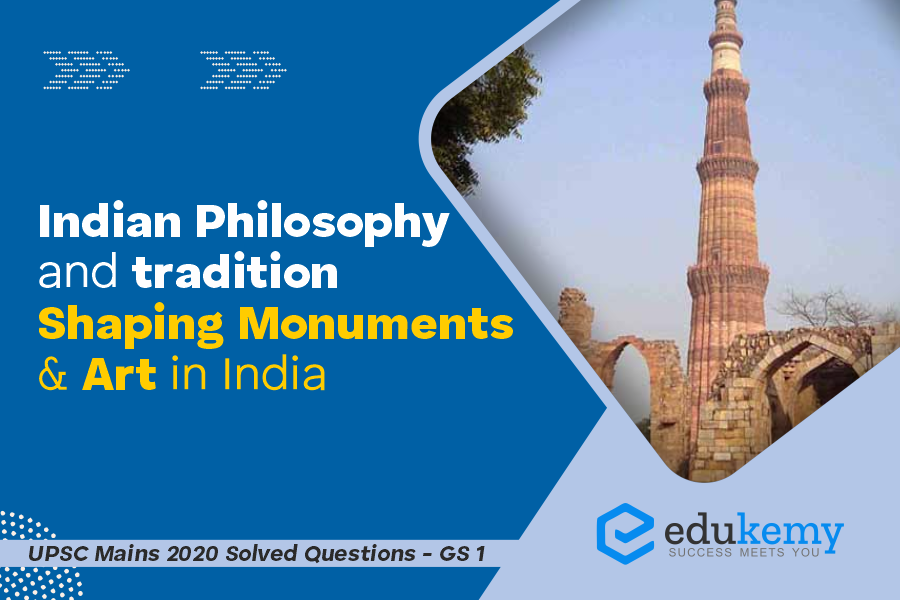Indian philosophy and tradition have played a profound and integral role in conceiving and shaping the monuments and artistry that grace the diverse landscapes of India. The rich tapestry of India’s cultural and spiritual heritage has been woven into the very fabric of its architectural marvels, reflecting the deep-seated beliefs and philosophical underpinnings of the civilization. From the intricate carvings of Hindu temples, such as the awe-inspiring Khajuraho and the majestic temples of Varanasi, to the serene symmetry of Buddhist stupas like Sanchi, the influence of philosophical concepts like dharma, karma, and moksha is palpable. The architectural language, symbolic motifs, and artistic expressions encapsulated in these monuments bear testimony to the synthesis of diverse philosophical schools, be it Vedanta, Jainism, Buddhism, or others. Each edifice becomes a visual manifestation of the quest for spiritual enlightenment, cosmic balance, and the interplay of the material and metaphysical realms. The enduring legacy of Indian philosophy continues to resonate in the timeless beauty and cultural significance of these monuments, acting as custodians of the nation’s intellectual and spiritual heritage.
UPSC Mains General Studies Paper – 1 Mains 2020
Indian Culture
UPSC Mains Civil Services IAS Exam Question Paper – 2020
Contents
- 1 Structure of the Question
- 2 Answer
- 3 Conclusion
- 4 Frequently Asked Questions (FAQs)
- 4.1 1. How did Indian philosophy influence the architectural design of monuments in India?
- 4.2 2. What role did Vastu Shastra, a traditional Indian architectural system, play in monument construction?
- 4.3 3. How did Hindu, Buddhist, and Jain philosophies contribute to diverse artistic expressions in Indian monuments?
- 4.4 4. In what ways did the concept of “Ahimsa” influence the depiction of art in Indian monuments?
- 4.5 5. How did the idea of “Murti” (divine images) in Indian philosophy shape the iconography of monuments?
- 5 In case you still have your doubts, contact us on 9811333901.
Structure of the Question
- In Introduction,
- Try to give a brief account of Indian Philosophy.
- In Body,
- Elaborate how Indian Philosophy impacted India’s Architecture and arts in different phases.
- Conclude by writing how people from different phases were keen to manifest and impart their traditions, values, and beliefs of Indian Philosophy.
Answer
Introduction
Indian philosophy refers to philosophical traditions which developed in the Indian subcontinent. It generally includes Hindu, Buddhist, and Jain Philosophy, among others. In the Indian context, from the Buddhist stupa and chaitya to the Hindu temple, and then to the Muslim Mosque or the Christian church, philosophy integrated deeply with religion has stimulated the art and architecture in India.
Impact of Indian Philosophy in the Ancient Period
Harappan Period:
The excavations at Harappa, Mohenjo-Daro, and several other sites revealed the existence of a very modern urban civilization with expert town planning and engineering skills. The swastika has tremendous philosophical and spiritual significance in contemporary India. Swastika has also been found among the Indus Valley diggings. According to many scholars, the popular Hindu god Siva had his origins as an Indus Valley deity which later gave rise to the cult of Shaivism.
Vedic Period:
The Varna system emerged in the Vedic Age having a great influence on Indian philosophy and tradition was also evident in how things got conceived and contributed to the structural growth of cities. In Rig Veda, while most of the texts deal with rites and rituals, and beliefs and practices other parts deal with abstract philosophical concepts. The Vedic people awed and overwhelmed by the forces of nature, ascribed divinity to fire, earth, sky, thunder, sun, dawn, dusk, etc. The most important feature of the Vedic period was the making of fire altars which soon became an important and integral part of the social and religious life of the people even today.
Buddhism and Jainism:
Engravings, paintings, or sculptures of these caves depict the teachings of these philosophies. For example, the ceilings of Ajanta caves have paintings showing the life cycles of Buddha, and Ellora caves contain images of 24 Jinas.
Ashoka Period:
The Ashokan Pillar and the Stupas have been influenced by the Buddhist philosophies depicting teachings, stories, and symbols associated with Buddhism. The Chakra of Sarnath’s pillar symbolizes Dharmachakrapravartana and the Chattra of stupas embodies the Three Jewels of Buddhism.
Gupta Period:
From the Gupta period onwards, Hindu temple architecture began to evolve. Constructed mainly in three distinctive styles, Nagara, Vesara, and Dravida, the architecture and walls of Hindu temples are influenced and embellished with sculptures influenced from Hindu epics and mythologies. The Khajuraho temple’s territory is laid out in three triangles that converge to form a pentagon to reflect the Hindu symbolism for three realms or Trilokinath, and five cosmic substances or Panchbhuteshvara.
Pallavas and the Cholas:
When the Pallavas and the Cholas reigned, there was a tradition where the temple used to be the central place in a village for societal communication. They extensively developed the tradition of building temples, for example, the ‘ratha’ at Mahabalipuram style of temples, structural temples such as the Kailashanath and Vaikunthperumal temples by the Pallavas.
Impact of Indian Philosophy in the Medieval Period
Mughal Emperor Akbar’s Dīn-i-Ilāhī known during its time as Tawḥīd-i-Ilāhī (“Oneness of God”) or Divine Faith, intending to merge some of the elements of the religions like Islam, Hinduism, and Zoroastrianism, Christianity, Jainism, and Buddhism. The synthesis between different cultures gave birth to new philosophical and religious traditions, ideas, forms and styles in almost all spheres of culture.
Impact of Indian Philosophy in the Modern India
During the British colonial period, European styles including neoclassical, gothic revival, and baroque became prevalent across India. The amalgamation of Indo-Islamic and European styles led to a new style, known as the Indo-Saracenic style.
Conclusion
The Indian philosophy and traditions have been a predominant factor influencing the architecture and interiors of the monuments. But, the monuments were not solely shaped by philosophies and they have incorporated activities such as trade or cultural interaction. The above examples show how people from different phases were keen to manifest and impart their traditions, values, and beliefs of Indian philosophy through art, and monuments, which helped to pass the knowledge through generations and through different styles.
Frequently Asked Questions (FAQs)
1. How did Indian philosophy influence the architectural design of monuments in India?
Indian philosophy, deeply rooted in concepts like Dharma, Karma, and Moksha, played a pivotal role in shaping the architectural landscape. The belief in cyclical existence and the pursuit of spiritual enlightenment influenced the layout and symbolism of monuments, reflecting a harmony between the physical and metaphysical realms.
2. What role did Vastu Shastra, a traditional Indian architectural system, play in monument construction?
Vastu Shastra, an ancient architectural treatise, guided the placement and layout of monuments based on cosmic principles. This traditional knowledge influenced the orientation, spatial organization, and even the choice of materials in the construction of Indian monuments, reflecting a holistic approach to architecture.
3. How did Hindu, Buddhist, and Jain philosophies contribute to diverse artistic expressions in Indian monuments?
The pluralistic nature of Indian philosophy is reflected in the rich variety of monuments influenced by Hindu, Buddhist, and Jain ideologies. Whether through intricate carvings, majestic temples, or serene stupas, each tradition left a unique imprint on the art, emphasizing different aspects of spirituality, morality, and the quest for higher knowledge.
4. In what ways did the concept of “Ahimsa” influence the depiction of art in Indian monuments?
The principle of “Ahimsa,” or non-violence, advocated by Indian philosophies, is mirrored in the artistic representations of monuments. Sculptures often depict scenes promoting compassion and non-violence, reflecting the ethical values inherent in Indian philosophical traditions.
5. How did the idea of “Murti” (divine images) in Indian philosophy shape the iconography of monuments?
The concept of “Murti” in Indian philosophy, representing the embodiment of the divine, greatly influenced the creation of sculptural art in monuments. Temples and other structures often housed intricately crafted statues, serving as a focal point for spiritual worship and reflection, reflecting the belief in the immanence of the divine in the material world.
In case you still have your doubts, contact us on 9811333901.
For UPSC Prelims Resources, Click here
For Daily Updates and Study Material:
Join our Telegram Channel – Edukemy for IAS
- 1. Learn through Videos – here
- 2. Be Exam Ready by Practicing Daily MCQs – here
- 3. Daily Newsletter – Get all your Current Affairs Covered – here
- 4. Mains Answer Writing Practice – here



